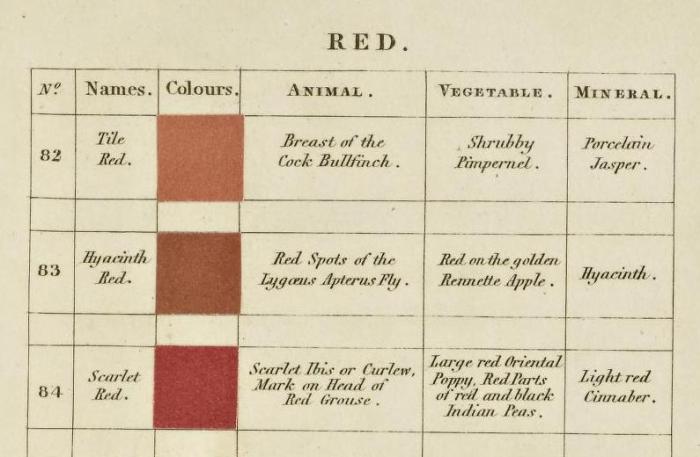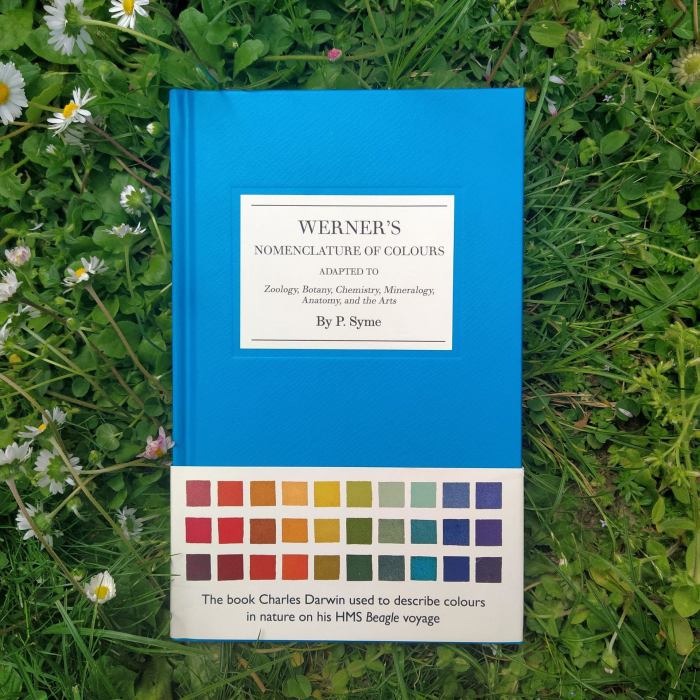Ever wondered how scientists and artists talk about color? Back in the 1800s, a dude named Werner was like, “Yo, we need a system for this!” He whipped up a color guide that became the ultimate color bible, influencing everything from zoology to painting.
Get ready for a wild ride through the history of color, where we’ll dive into the crazy world of “Werner’s Nomenclature of Colours – Adapted to Zoology Botany Chemistry Mineralogy Anatomy and the Arts.”
This book wasn’t just some dusty old tome; it was a game-changer. Imagine trying to describe a rare bird’s plumage or a mineral’s shimmer without a universal language. Werner’s system provided that, giving scientists and artists a common ground for talking about color.
Think of it like the “Urban Dictionary” of color, but way more scientific and less… well, you know.
Historical Context and Significance

Werner’s Nomenclature of Colours, published in 1814, was a groundbreaking work that revolutionized the way colors were named and categorized. This comprehensive system, developed by German mineralogist Abraham Gottlob Werner, provided a standardized and precise language for describing colors, which had a profound impact on various scientific disciplines and artistic practices in the 19th century.
Impact on Scientific Disciplines
The influence of Werner’s Nomenclature of Colours extended beyond the realm of mineralogy. It provided a valuable tool for scientists in fields such as zoology, botany, chemistry, and anatomy. By establishing a common language for color description, Werner’s work facilitated communication, collaboration, and the accurate recording of observations.
- Zoologists used Werner’s system to document the colors of animals, aiding in their classification and identification.
- Botanists relied on Werner’s nomenclature to describe the intricate colors of plants, contributing to the development of botanical illustrations and the understanding of plant diversity.
- Chemists found Werner’s system useful in characterizing the colors of chemical compounds, advancing their understanding of chemical reactions and properties.
- Anatomists utilized Werner’s nomenclature to describe the colors of human tissues and organs, contributing to the advancement of anatomical studies.
Patrick Syme’s Contributions
Patrick Syme, a Scottish botanist and physician, played a pivotal role in adapting Werner’s nomenclature for English-speaking audiences. His work, “Werner’s Nomenclature of Colours, with Additions, Arranged So as to Render It Highly Useful to Artists and Others,” published in 1829, popularized Werner’s system in Britain and beyond.
Syme’s adaptation included a detailed description of each color, along with numerous examples from the natural world.
“The colours of nature are infinite, and it is impossible to express them all by words; but by a proper selection of terms, and by a judicious arrangement of them, we may be enabled to describe the most important and striking colours with sufficient accuracy.”
Patrick Syme, Werner’s Nomenclature of Colours, 1829.
Yo, so Werner’s Nomenclature of Colours – Adapted to Zoology Botany Chemistry Mineralogy Anatomy and the Arts is like, the OG color guide, right? It’s got all the shades and hues, from the deepest indigo to the brightest yellow.
You can totally download and listen to it Download And Listen Here , which is super rad for anyone who’s into color theory or just wants to know the names of all those crazy colors. I mean, who knew there were so many shades of green, right?
So, yeah, check out Werner’s book, it’s like, the ultimate color dictionary.
Structure and Organization of the Book

Werner’s Nomenclature of Colours is structured in a way that makes it easy to navigate and use. It’s like a color-coded map for the world of hues, organized in a logical and systematic manner.
Color Categories and Subdivisions
The book divides colors into four main categories: primary, secondary, tertiary, and neutral. Each category is further subdivided into specific color groups. For example, primary colors include red, yellow, and blue, while secondary colors are created by mixing two primary colors.
Color Charts and Terminology
Werner uses color charts to visually represent each color. These charts are arranged in a grid format, with each square representing a specific color. He uses a precise and detailed system for naming colors, including specific terms like “azure,” “vermilion,” and “indigo.” This system helps to ensure consistency and accuracy in color identification.
“The nomenclature of colours is a subject of great importance in various branches of science and art.”
Patrick Syme, editor of the 1814 edition of Werner’s Nomenclature of Colours
Color Descriptions and Examples
Werner provides detailed descriptions of each color, including its properties, characteristics, and examples of where it can be found in nature, art, and science. He uses vivid language to evoke the essence of each color, allowing readers to visualize the hues he describes.
For instance, he describes “ultramarine blue” as “the richest and most beautiful of all blues.”
Index and Glossary
The book includes a comprehensive index and glossary, making it easy to find specific colors and terms. This feature enhances the book’s usability, allowing readers to quickly access the information they need.
Applications and Impact

Werner’s “Nomenclature of Colours” wasn’t just a cool color chart; it was a game-changer for science and art. This book was like the color-coding system for the whole world, making it easier for people to talk about and understand colors in a consistent way.
Impact on Color Theory and Practice
Werner’s book had a major impact on the way people thought about and used color. Before Werner, there was no standard way to name or describe colors. People used vague terms like “reddish” or “bluish,” which could mean different things to different people.
Werner’s Nomenclature of Colours is like a total vibe check for the natural world, ya know? It’s got shades for everything from a butterfly’s wing to a gemstone’s sparkle. And if you’re looking to bring some of that color inspiration into your own life, check out 2024 Vision Board Clip Art Book An Extensive Collection of Inspiring Images Quotes & Affirmations for Personal Growth Goal Setting and …
& words (2024 Vision Board Clip Art Books). This book is all about using colors and imagery to manifest your dreams. It’s like Werner’s guide to the soul, but with a whole lot more glitter.
Werner’s system provided a clear and precise way to communicate about color, which was a huge step forward for science, art, and communication in general.
“Werner’s work helped to establish a common language for color, which was essential for the development of color theory and practice.”
Applications in Various Fields
Werner’s system was quickly adopted by scientists and artists alike.
- Botany:Botanists used Werner’s system to describe the colors of plants, which helped them to identify and classify different species. This was super helpful for understanding the diversity of plant life and for developing new plant-based medicines.
- Zoology:Zoologists used Werner’s system to describe the colors of animals, which helped them to identify and classify different species. This was important for understanding animal behavior and for conservation efforts.
- Mineralogy:Mineralogists used Werner’s system to describe the colors of minerals, which helped them to identify and classify different minerals. This was important for understanding the Earth’s geology and for finding new mineral resources.
- Anatomy:Anatomists used Werner’s system to describe the colors of human tissues and organs, which helped them to understand human anatomy and physiology. This was important for medical diagnosis and treatment.
- Art:Artists used Werner’s system to create more accurate and consistent color palettes. This helped them to create more realistic and expressive artwork. Think about how much easier it was to mix colors when you could say, “I need a bit more ‘Greenish Blue’ in this painting!”
Comparison with Other Color Classification Systems
Werner’s system wasn’t the only color classification system around at the time. However, it was one of the most comprehensive and widely used.
- Other Systems:Other systems, like those developed by Isaac Newton and Michel Eugène Chevreul, focused more on the scientific principles of color, but Werner’s system was more practical and user-friendly. It was easier to use in everyday life and was quickly adopted by scientists and artists alike.
- Werner’s System:Werner’s system was based on a simple, intuitive system of color names and descriptions. This made it easy to understand and use, even for people who were not familiar with color theory.
Book Review
Werner’s Nomenclature of Colours, a masterpiece of scientific observation and meticulous detail, is a remarkable testament to the enduring power of color classification. Published in 1814, this book transcends the boundaries of traditional color charts and presents a comprehensive system that revolutionized the way we understand and communicate about color.
The Book’s Strengths
Werner’s Nomenclature of Colours stands as a testament to the author’s meticulous approach and unwavering dedication to accuracy. The book’s strengths lie in its systematic organization, comprehensive scope, and practical applications. Werner’s system is based on a logical and hierarchical framework.
He begins by categorizing colors into primary, secondary, and tertiary hues, then further subdivides each category into distinct shades and tints. This systematic approach allows for precise identification and communication of color variations, ensuring clarity and consistency in scientific and artistic discourse.The book’s scope is truly remarkable.
It encompasses a vast range of colors, from the most common to the rarest, covering everything from natural phenomena to manufactured materials. This breadth of coverage makes it an invaluable resource for researchers and practitioners across various disciplines.Werner’s Nomenclature of Colours is not merely a theoretical treatise; it is a practical tool for color analysis and communication.
The book includes detailed descriptions of each color, accompanied by precise measurements and standardized color samples. This practical approach makes it an indispensable guide for artists, designers, and scientists alike.
The Book’s Weaknesses
While Werner’s Nomenclature of Colours is a groundbreaking work, it is not without its limitations. The book’s reliance on a limited set of color samples can present challenges for accurate color matching, particularly when dealing with subtle variations or complex color combinations.
Furthermore, the book’s focus on natural and manufactured materials may limit its applicability to modern color systems, which often rely on digital and synthetic color palettes.
The Book’s Lasting Impact
Despite these limitations, Werner’s Nomenclature of Colours has had a profound and lasting impact on scientific and artistic discourse. It laid the foundation for modern color classification systems, influencing the development of color theory, colorimetry, and color reproduction. The book’s meticulous approach to color identification and communication continues to inspire researchers and practitioners in fields as diverse as botany, zoology, chemistry, and mineralogy.
Artists and designers still draw inspiration from Werner’s work, using his system to create vibrant and evocative color palettes.Werner’s Nomenclature of Colours is a timeless masterpiece that continues to be relevant and influential today. It serves as a reminder of the enduring power of scientific observation, meticulous detail, and the importance of precise communication.
Wrap-Up
So, there you have it! Werner’s color code might not be as hip as the latest color trends on Instagram, but it’s the foundation of how we understand color today. From classifying the rainbow to making sure your art supplies are on point, this book has been a real game-changer.
And hey, maybe it’s time we give Werner the credit he deserves for making color so much more than just a pretty picture.
Helpful Answers
What’s the big deal about “Werner’s Nomenclature of Colours”?
It basically created the first standardized system for describing and classifying colors. Before this, it was like everyone was speaking a different language when talking about shades and hues.
Did Werner invent all the colors?
Nah, he was more like a color organizer. He took existing color knowledge and put it into a system that everyone could use.
Is this book still relevant today?
Totally! While color systems have evolved, Werner’s work laid the groundwork for how we understand color in science, art, and even everyday life.

